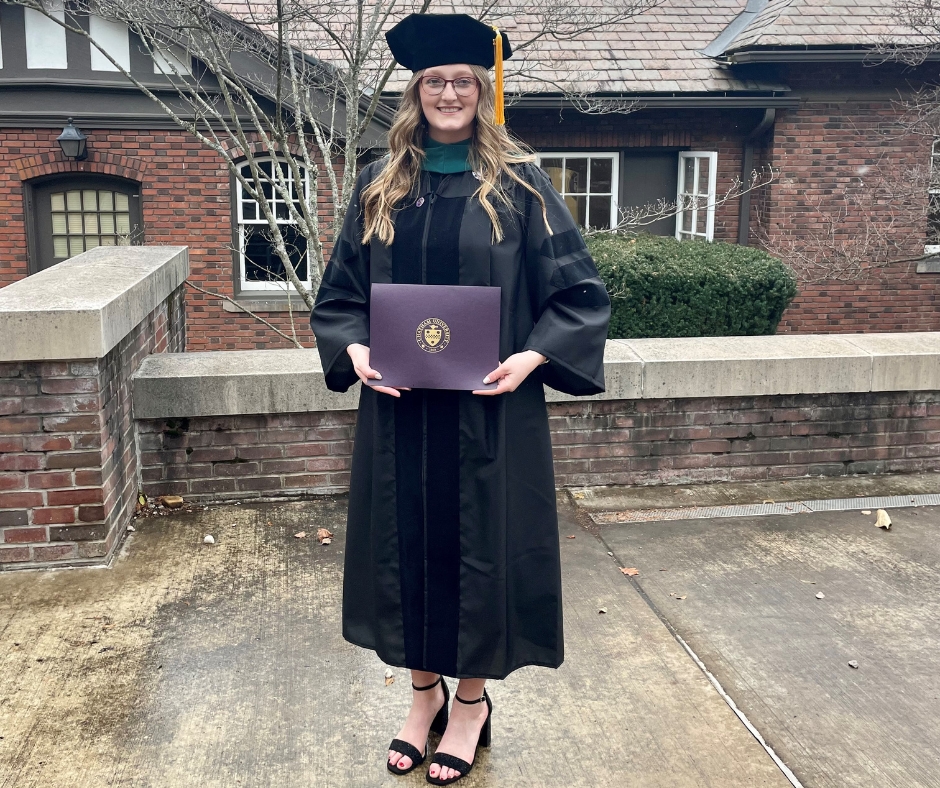As a physical therapist, Stoll often measures success in small steps.
Madeleine Stoll (WC ’16) doesn’t have too many fond memories of her first two years at Worthington Christian High School. However, those two years served a formative role in her career choice.
After earning a doctorate in physical therapy from Chatham University in Pittsburgh, Stoll recently started working in the acute physical therapy department at the OhioHealth Grant Medical Center in downtown Columbus.
“It’s definitely a big sigh of relief,” Stoll said, completing her doctorate. “I’ve been working on this for almost seven years. It’s nice to be done finally and start my career.”
Stoll has something unusual to thank for helping her discover her love of physical therapy: chronic acute migraine headaches. Migraines forced her to miss many of her freshman and sophomore years of high school.
“I felt like I wasn’t really in school my first two years,” she said. “When I did go to school, stress would cause another migraine which made me miss even more school.
“I always had a headache that never went away, but when a migraine would come along, the pain level would shoot up to a 20 on a scale of 1-10 pain level. I’d be sitting in class, and suddenly, the lights would become too bright, and I couldn’t keep my eyes open.”
Stoll went to the Cleveland Clinic for a three-week intensive program to learn stress and pain management skills that made it possible for her to attend school. Over time, the exercises she learned helped dissipate the migraine headaches. She has only had one migraine since graduating high school.
During her stay at the Cleveland Clinic, Stoll was introduced to the role of a physical therapist. Before that visit, she viewed physical therapists as someone who help people through sports injuries and back pain. In Cleveland, she learned those were just part of the branches one can do as a PT
“I spent an hour daily with my physical therapists,” Stoll said. “I really got to know them and developed a cool relationship with them.
“While I was there, I saw this patient who had sustained a spinal cord injury and was in a halo brace, a device used to protect the cervical spine and neck after an injury. The therapists were teaching her how to walk again. I thought, ‘This is the most amazing thing I’ve ever seen.’ This girl, encapsulated in metal, was learning how to regain her life.”
Watching PTs in action and her high school anatomy class cemented Stoll’s decision to become a physical therapist.
“I absolutely fell in love with how God has created our bodies, from the cells to the muscles to the organs,” she said. “(By becoming a PT) I can help bring people back into their prior level of function.”
After completing an undergraduate program in exercise science and pre-physical therapy at the University of Akron, Stoll discovered Chatham University and its problem-based learning program.
At the Pittsburgh-based university, students often met in groups and shared their research on disorders and treatment implications for PTs.
“It’s kind of a flipped classroom technique,” she said. “I felt like I was working in the real world and not going to class and having a professor lecture you, ‘OK, this next patient has this disorder. Here’s what you need to know about it.’ You must research it yourself.”
The project-based learning helped when Stoll was in one of her clinicals at the Select Specialty Hospital-Alle Kiski in Natrona Heights, Pa. Things seemed to come full circle for Stoll during this rotation. After watching a person relearn how to walk through the work of the Cleveland Clinic PTs, Stoll said one of her most satisfying experiences was putting together a treatment plan for a stroke victim to regain his ability to walk.
At first, Stoll helped the patient with weight shifts and would hold his leg in place to keep it from buckling under him when he stood. Soon he was able to walk five feet with three people supporting him.
Each day, they would try a longer distance. When Stoll’s rotation was up, the patient could go 75 feet with minimal assistance.
“Every day after that, he got better and better, a little bit faster,” Stoll said. “It was really cool to watch him progress through that.”
